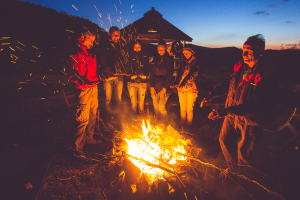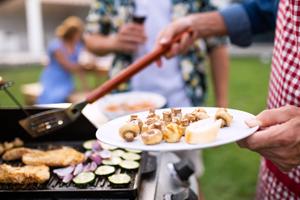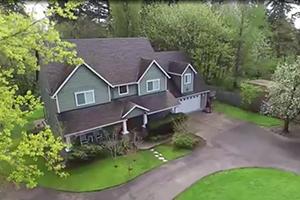How to have a safe bonfire

Sitting around a bonfire with family and friends is a fun way to wind down an evening. When we roast marshmallows and spend time with friends, however, it’s easy to forget about the risk factors involved with outdoor fires.
Up to 90 percent of wildland fires in the United States are caused by humans, in many cases resulting from campfires or bonfires left unattended with loose embers and burning debris. Here are some safety guidelines to follow before the first match is lit.
Bonfire safety guidelines
- Build the bonfire at least 10 feet away from any structures and combustible materials.
- Be mindful of the weather. Never build a bonfire with extremely windy or dry conditions in the forecast.
- Check with your municipality for any rules or regulations about having bonfires, and if any burn bans are in place.
- Keep a bucket of water or garden hose nearby in case the fire begins to spread. Dirt and sand can also be used to extinguish the fire in the absence of water. It is important to be prepared in case of emergency.
- Keep a close eye on the bonfire, especially if children and pets are nearby. Explain safety precautions to kids so they know where to go and how to act around a fire.
- Avoid using accelerants such as aerosol cans, pressurized containers and glass and aluminum cans to prevent explosions or harmful fumes.
Things to keep in mind
Wear appropriate clothing — wear non-flammable clothing when starting, sitting by or extinguishing the fire. Hard-soled shoes are a better choice than rubber sneakers or flip flops, as leaping sparks could cause their material to ignite.
Keep an eye on alcohol consumption — if you and your guests are enjoying an adult beverage around the bonfire, be mindful of your consumption. Too much alcohol can lead to clumsiness and careless behavior, such as getting too close to the fire or tossing in the wrong items.
Put out the fire safely — when the evening comes to a close, and you’ve let the fire burn out, use a shovel to spread out the ashes and let them cool down. Slowly pour water over the ashes and monitor them closely to be sure that no burning embers remain. Place the cooled ashes in a metal can that is designated for ash storage only. You should not leave the site until you know the fire is fully out.
Stay protected
If you plan on having a bonfire this summer, talk to your independent insurance agent about insurance coverage you may need to protect your family, your home and your assets. Looking for insurance guidance? Find an agent in your area.
Sources:
Insurance Information Institute
Mosquito Magnet
U.S. National Forest Service
Related resources
How to have a safe bonfire
Sitting around a bonfire with family and friends is a fun way to wind down an evening. When we roast marshmallows and spend time with friends, however, it’s easy to forget about the risk factors involved with outdoor fires.
Up to 90 percent of wildland fires in the United States are caused by humans, in many cases resulting from campfires or bonfires left unattended with loose embers and burning debris. Here are some safety guidelines to follow before the first match is lit.
Bonfire safety guidelines
- Build the bonfire at least 10 feet away from any structures and combustible materials.
- Be mindful of the weather. Never build a bonfire with extremely windy or dry conditions in the forecast.
- Check with your municipality for any rules or regulations about having bonfires, and if any burn bans are in place.
- Keep a bucket of water or garden hose nearby in case the fire begins to spread. Dirt and sand can also be used to extinguish the fire in the absence of water. It is important to be prepared in case of emergency.
- Keep a close eye on the bonfire, especially if children and pets are nearby. Explain safety precautions to kids so they know where to go and how to act around a fire.
- Avoid using accelerants such as aerosol cans, pressurized containers and glass and aluminum cans to prevent explosions or harmful fumes.
Things to keep in mind
Wear appropriate clothing — wear non-flammable clothing when starting, sitting by or extinguishing the fire. Hard-soled shoes are a better choice than rubber sneakers or flip flops, as leaping sparks could cause their material to ignite.
Keep an eye on alcohol consumption — if you and your guests are enjoying an adult beverage around the bonfire, be mindful of your consumption. Too much alcohol can lead to clumsiness and careless behavior, such as getting too close to the fire or tossing in the wrong items.
Put out the fire safely — when the evening comes to a close, and you’ve let the fire burn out, use a shovel to spread out the ashes and let them cool down. Slowly pour water over the ashes and monitor them closely to be sure that no burning embers remain. Place the cooled ashes in a metal can that is designated for ash storage only. You should not leave the site until you know the fire is fully out.
Stay protected
If you plan on having a bonfire this summer, talk to your independent insurance agent about insurance coverage you may need to protect your family, your home and your assets. Looking for insurance guidance? Find an agent in your area.
Sources:
Insurance Information Institute
Mosquito Magnet
U.S. National Forest Service
Related resources
How to have a safe bonfire
Sitting around a bonfire with family and friends is a fun way to wind down an evening. When we roast marshmallows and spend time with friends, however, it’s easy to forget about the risk factors involved with outdoor fires.
Up to 90 percent of wildland fires in the United States are caused by humans, in many cases resulting from campfires or bonfires left unattended with loose embers and burning debris. Here are some safety guidelines to follow before the first match is lit.
Bonfire safety guidelines
- Build the bonfire at least 10 feet away from any structures and combustible materials.
- Be mindful of the weather. Never build a bonfire with extremely windy or dry conditions in the forecast.
- Check with your municipality for any rules or regulations about having bonfires, and if any burn bans are in place.
- Keep a bucket of water or garden hose nearby in case the fire begins to spread. Dirt and sand can also be used to extinguish the fire in the absence of water. It is important to be prepared in case of emergency.
- Keep a close eye on the bonfire, especially if children and pets are nearby. Explain safety precautions to kids so they know where to go and how to act around a fire.
- Avoid using accelerants such as aerosol cans, pressurized containers and glass and aluminum cans to prevent explosions or harmful fumes.
Things to keep in mind
Wear appropriate clothing — wear non-flammable clothing when starting, sitting by or extinguishing the fire. Hard-soled shoes are a better choice than rubber sneakers or flip flops, as leaping sparks could cause their material to ignite.
Keep an eye on alcohol consumption — if you and your guests are enjoying an adult beverage around the bonfire, be mindful of your consumption. Too much alcohol can lead to clumsiness and careless behavior, such as getting too close to the fire or tossing in the wrong items.
Put out the fire safely — when the evening comes to a close, and you’ve let the fire burn out, use a shovel to spread out the ashes and let them cool down. Slowly pour water over the ashes and monitor them closely to be sure that no burning embers remain. Place the cooled ashes in a metal can that is designated for ash storage only. You should not leave the site until you know the fire is fully out.
Stay protected
If you plan on having a bonfire this summer, talk to your independent insurance agent about insurance coverage you may need to protect your family, your home and your assets. Looking for insurance guidance? Find an agent in your area.
Sources:
Insurance Information Institute
Mosquito Magnet
U.S. National Forest Service
Related resources
How to have a safe bonfire
Sitting around a bonfire with family and friends is a fun way to wind down an evening. When we roast marshmallows and spend time with friends, however, it’s easy to forget about the risk factors involved with outdoor fires.
Up to 90 percent of wildland fires in the United States are caused by humans, in many cases resulting from campfires or bonfires left unattended with loose embers and burning debris. Here are some safety guidelines to follow before the first match is lit.
Bonfire safety guidelines
- Build the bonfire at least 10 feet away from any structures and combustible materials.
- Be mindful of the weather. Never build a bonfire with extremely windy or dry conditions in the forecast.
- Check with your municipality for any rules or regulations about having bonfires, and if any burn bans are in place.
- Keep a bucket of water or garden hose nearby in case the fire begins to spread. Dirt and sand can also be used to extinguish the fire in the absence of water. It is important to be prepared in case of emergency.
- Keep a close eye on the bonfire, especially if children and pets are nearby. Explain safety precautions to kids so they know where to go and how to act around a fire.
- Avoid using accelerants such as aerosol cans, pressurized containers and glass and aluminum cans to prevent explosions or harmful fumes.
Things to keep in mind
Wear appropriate clothing — wear non-flammable clothing when starting, sitting by or extinguishing the fire. Hard-soled shoes are a better choice than rubber sneakers or flip flops, as leaping sparks could cause their material to ignite.
Keep an eye on alcohol consumption — if you and your guests are enjoying an adult beverage around the bonfire, be mindful of your consumption. Too much alcohol can lead to clumsiness and careless behavior, such as getting too close to the fire or tossing in the wrong items.
Put out the fire safely — when the evening comes to a close, and you’ve let the fire burn out, use a shovel to spread out the ashes and let them cool down. Slowly pour water over the ashes and monitor them closely to be sure that no burning embers remain. Place the cooled ashes in a metal can that is designated for ash storage only. You should not leave the site until you know the fire is fully out.
Stay protected
If you plan on having a bonfire this summer, talk to your independent insurance agent about insurance coverage you may need to protect your family, your home and your assets. Looking for insurance guidance? Find an agent in your area.
Sources:
Insurance Information Institute
Mosquito Magnet
U.S. National Forest Service





